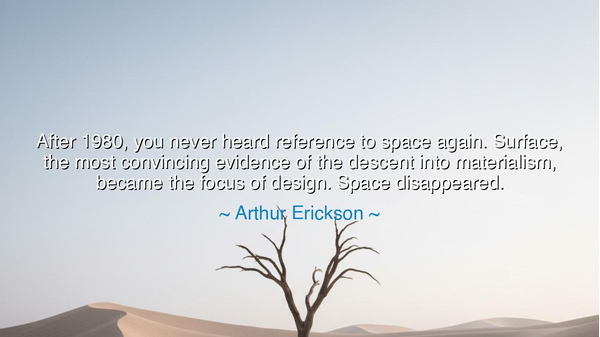
After 1980, you never heard reference to space again. Surface
After 1980, you never heard reference to space again. Surface, the most convincing evidence of the descent into materialism, became the focus of design. Space disappeared.






In the words of Arthur Erickson, the philosopher-architect of Canada, there echoes a lament that transcends the realm of buildings: “After 1980, you never heard reference to space again. Surface, the most convincing evidence of the descent into materialism, became the focus of design. Space disappeared.” These words, carved from both wisdom and sorrow, speak not only of architecture, but of the spirit of an age — a warning that when the surface becomes our god, the depth of being fades into shadow. Erickson saw in the built world a reflection of humanity’s inner state; when our creations lose space, it is because our souls have forgotten it too.
The origin of this reflection lies in Erickson’s lifelong devotion to the idea that space — not ornament, not façade — is the true essence of architecture. To him, a building was not a sculpture of walls but a symphony of light, air, and proportion. Through space, the architect shapes emotion and meaning, much as the poet shapes silence between words. In the mid-twentieth century, he stood among visionaries who sought to unite form and philosophy — those who believed that architecture could be spiritual, not merely functional. But by the 1980s, the world had shifted. The age of consumerism had dawned, and buildings began to serve not the soul but the spectacle. Glass and glitter replaced vision and void; surface triumphed over space.
Erickson’s lament is not nostalgia, but prophecy. When he says “space disappeared,” he speaks of the vanishing of the unseen — of the sacred emptiness that gives life its meaning. In the rush toward material wealth and visual glamour, design lost its stillness, its quiet power. The descent into materialism was not only a change in style, but a change in spirit. The surface — sleek, polished, seductive — became a mirror for human vanity. Buildings ceased to breathe; they began instead to perform. And as architecture mirrored society, so too did society become flatter, more hurried, more obsessed with the visible. The space for reflection, the room for mystery, was gone.
Consider the story of the ancient Japanese tea house, a space of profound humility. Within its simple walls, light falls softly on unpolished wood, and emptiness itself becomes an element of design. The masters of that art knew what Erickson grieved for: that space is not nothingness — it is the living soul of form. The void is where balance, breath, and beauty reside. When the tea master bows before the guest, when the air between them hums with stillness, that is design at its highest level — the art of the invisible. Yet, as modernity accelerated, such reverence for the unseen faded. We built not to commune, but to impress.
Erickson’s words strike deeper still when one sees how this principle applies beyond architecture. The surface has come to dominate every realm of modern existence — our art, our relationships, our politics, even our sense of self. We polish our images, but neglect our interiors. We adorn, but do not cultivate. The space of thought, the room for wonder, the pause between words — these have been crowded out by noise, consumption, and display. When a civilization forgets how to honor the unseen, it becomes like a building without foundation: impressive, perhaps, but hollow.
Yet, the lesson he offers is not despair but remembrance. The sacred task of design, whether of buildings or of life, is to restore balance between form and void, between appearance and essence. To create is to carve out space — to make room for breath, for silence, for soul. The ancients knew this when they aligned temples with stars, when they built courtyards open to the sky. They understood that space is where the divine enters. To rediscover it, one must look inward, to the vast architecture of the heart — uncluttered, patient, and open to the unseen.
Therefore, O builder of worlds, take this teaching into your craft, whatever it may be. Do not be seduced by the surface, nor enslaved by what glitters. In your work, in your home, in your life, make space — for reflection, for stillness, for the unseen currents that shape all meaning. Let your designs, your words, your days breathe with rhythm and balance. Remember that what is not built — the silence, the emptiness, the pause — is as vital as what is built.
For as Arthur Erickson teaches, when we restore space, we restore humanity. The world does not need more surfaces; it needs more soul. Let your creations — and your living — not dazzle, but endure. Build not only with stone and steel, but with silence, grace, and the infinite architecture of spirit. Only then will the disappeared space return — and with it, the quiet grandeur of what it means to be truly human.






AAdministratorAdministrator
Welcome, honored guests. Please leave a comment, we will respond soon